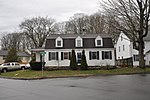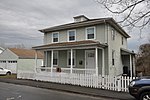Yale Corinthian Yacht Club
1881 establishments in Connecticut1987 America's CupBuildings and structures in Branford, ConnecticutCollege sailing venues in the United StatesLong Island Sound ... and 5 more
Sailing clubs in ConnecticutSailing in ConnecticutSports clubs and teams established in 1881Sports venues completed in 1881Yale Bulldogs sailing

Yale Corinthian Yacht Club is a public sailing facility located on Short Beach in Branford, Connecticut (United States), home of the Yale University sailing team. It is generally abbreviated as "YCYC" and is affectionately pronounced "yic-yic." Founded in 1881, it is the oldest collegiate sailing club in the world. YCYC is about six miles from campus. Student officers, such as the commodore, secretary, and fleet captain, run the club. They manage everything from the facilities and fleet to fund-raising and hosting events,
Excerpt from the Wikipedia article Yale Corinthian Yacht Club (License: CC BY-SA 3.0, Authors, Images).Yale Corinthian Yacht Club
Clark Avenue,
Geographical coordinates (GPS) Address Nearby Places Show on map
Geographical coordinates (GPS)
| Latitude | Longitude |
|---|---|
| N 41.256 ° | E -72.851 ° |
Address
Yale Corinthian Yacht Club Parking
Clark Avenue 179
06405
Connecticut, United States
Open on Google Maps









